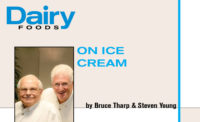Dairy manufacturers minimize total and added sugar
Allulose and improved stevia extracts are ingredients to watch

Dairy foods are ideal components of a sensible weight management plan, but added sugars can sabotage the healthy aspects of those foods.
Gen Xers, for example, are now in their 40s and 50s, the age where it becomes increasing difficult to stave off those extra pounds. According to the International Food Information Council, a full 78% of this group is trying to limit or avoid sugars (https://tinyurl.com/v9zksv5).
Jan. 1, 2020, was the deadline for large food manufacturers to switch to the new Nutrition Facts labels and declare “added sugars.” Surveys indicate that consumers are scrutinizing the new labels closely to limit both total and added sugars in their diet.
Reduction strategies
“Sugar reduction in dairy is often complicated,” notes Christine Addington, senior dairy technical service specialist for Cargill, Minneapolis. “It not only provides sweetness and flavor, it also contributes to mouthfeel, texture, moisture control, freezing-point depression, microbial control and more. As a result, successful sugar reduction often requires a combination of ingredients.”
Fortunately, dairy formulators have a sophisticated range of ingredients for sugar reduction in their toolbox. Two of them — allulose and stevia — deserve special mention.
In April 2019, the FDA released draft guidance on allulose, a rare sugar, indicating that it did not have to be included in total or added sugars on the food label.
“In dairy applications, allulose provides freeze-point depression, making it an excellent candidate for sugar and calorie reduction in frozen desserts like ice cream,” says Didem Icoz, senior business scientist for Westchester, Ill.-based Ingredion Incorporated.
“Allulose also does not crystallize in high-solid food systems such as fruit preps used in blended yogurts,” Icoz adds. “It provides superior refrigerated storage stability in fruit preps for yogurts for at least three months. Allulose is about 70% as sweet as table sugar.”
And since 2008, the FDA has received over 50 Generally Recognized as Safe, or GRAS, petitions for various stevia extracts. The latest generation of steviol glycosides consists of cleaner ingredients that provide synergy with other sugar-reducing ingredients.
“We’ve been working with flavored milks for years, getting all the way to no sugar added, using our next-generation stevia products coupled with carrageenan, chicory root fiber or native starches to replicate the mouthfeel of a full-sugar offering,” Addington notes. “In yogurts, sweetener solutions must balance the product’s inherent acidity.
“Ice cream is especially difficult because sugar brings so much to the table,” she adds, “impacting freezing point and many sensory characteristics. Erythritol can help replicate some of sugar’s functional roles, especially freezing point depression. But to replace all of sugar’s sweet taste, it’s often paired with stevia, along with other bulking agents like inulin to help with mouthfeel.”
Sugar countdown
There’s a lot of innovation in the dairy aisle, and industry is utilizing an amazing array of different sweeteners.
For example, a 15.2-ounce bottle of Bolthouse Farms lower-sugar coffee protein shake, made with whey protein concentrate, has only 16 grams of sugar, 70% less than similar products. It is sweetened with monk fruit juice concentrate.
Noosa, a brand that’s synonymous with indulgence, uses cane sugar to sweeten its new Noosa Hīlö yogurt line, which weighs in at just 12 grams of sugar per 5.3-ounce serving. And FAGE TruBlend yogurt boasts “no added sugar” and “no sweeteners.” A 5.3-ounce serving delivers just 6 grams of sugar. Chicory root fiber provides natural sweetness.
A half cup of Halo Top Chocolate Chip Cookie Dough ice cream, meanwhile, contains just 7 grams of sugar. It is sweetened with erythritol, cane sugar, prebiotic fiber and stevia leaf extract.
With so many options, there’s a lower-sugar dairy treat for every sweet tooth.
Looking for a reprint of this article?
From high-res PDFs to custom plaques, order your copy today!






